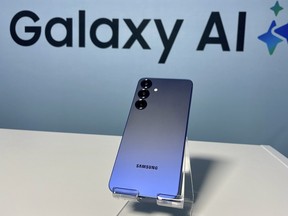Samsung’s new operating system is shifting from having AI features mostly within applications to a system-wide approach

The company launched three new devices at an event Wednesday in San Jose, California: the S25 starting at US$799, a larger S25+ and the top-tier S25 Ultra priced from US$1,299 and up. Spanning 6.9 inches in size, the new Ultra model gains the most significant design changes and camera hardware upgrades.
Samsung has sustained an impressive pace of double-digit growth with its S series over the past two years, selling 35 million units of its most recent flagship, the Galaxy S24 family, according to Counterpoint Research data. The company has shifted its focus to higher-tier handsets and now commands a fifth of the global premium market — models costing $800 and above — and increased its average selling price to US$448, IDC market research showed.
The new models largely adhere to Samsung’s established design language, all slightly thinner and lighter, with the Ultra edition slimming down the borders around the display by 15 per cent. The S25 Ultra also gets a new Gorilla Glass screen that makes it 29 per cent more resistant to cracking, Samsung said, and new rounded edges to go with its titanium frame. That distinguishes it from the aluminum on the more affordable models.
With the latest operating system, Samsung is shifting from having AI features mostly within applications to a system-wide approach, the company showed in demonstrations. For instance, there’s a new capability called AI Select that works across the operating system to identify areas where artificial intelligence can be used, such as summarizing the transcript of a YouTube video.
The most significant new feature: so-called cross app actions, which allow users to ask the AI system to do multiple tasks in one command. For instance, they can ask the device to find a local restaurant and provide reviews, while also adding a reservation to their calendar and text-messaging the details to friends.
One of the main AI features from last year’s devices — Circle to Search — is getting upgraded to allow a user to circle a phone number, website or email address to quickly take action. Samsung representatives said Circle to Search is one of the most popular AI features on its devices and that 10 million users have accessed it. The company said 20 per cent of Galaxy users engage with AI — a number it would like to increase with this year’s upgrades.
There are also new user interfaces for AI, including a Now Brief section that proactively provides a summary for things like sleep data, weather forecasts, reminders and calendar items. It also can make suggestions based on a user’s habits. Or the system could provide recommendations on when to leave for a meeting, based on traffic conditions and other calendar appointments.
And there’s a Now Bar — similar to the Live Activities feature on the iPhone — that will show sports scores, turn-by-turn navigation and other live data on the device’s lock screen.
The company also aims to improve overall performance by raising the memory on the base model from 8 gigabytes to 12 gigabytes. That matches the S25+ and S25 Ultra.
Internally, Samsung has made hardware changes to allow advanced AI models and applications to run longer without heating up the phone. To do that, the company has improved the vapour chamber — technology to dissipate heat — by making the area within the phone 40 per cent larger on the Ultra model and 15 per cent bigger on the other variants, the company said.
The new models have similar camera technology as their predecessors, though the Ultra version moves from a 12-megapixel ultrawide rear camera on the S24 to a 50-megapixel sensor this year.
That phone otherwise still includes a 200-megapixel wide camera and 10-megapixel and 50-megapixel telephoto lenses. The non-Ultra phones have a single 10-megapixel telephoto lens, a 50-megapixel wide camera and a 12-megapixel ultrawide lens.
The new models also include improved clarity for videos shot in low light and a new feature that can isolate and erase certain sounds from video, as well as improvements for depth-of-field control and colour grading, the company showed in a demonstration.
—With assistance from Vlad Savov.